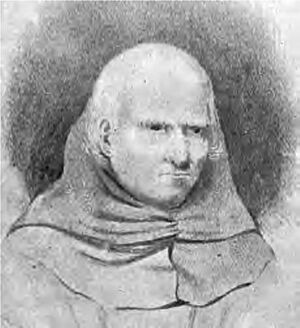Gerónimo Boscana facts for kids
Gerónimo Boscana was a Franciscan missionary in the early 1800s. He worked in areas that are now part of California. He is famous for writing a very detailed book about the culture of Native Californian people. His writings are considered important because they give us a rare look into their lives during that time.
Life of Gerónimo Boscana
Gerónimo Boscana was born in 1775 on the island of Mallorca, Spain. He joined the Franciscan order in 1792 and became a priest in 1799.
In 1803, he traveled to New Spain, which included parts of North America. He arrived in Alta California in 1806. He worked at several missions there. These included Mission Soledad and La Purísima Mission. He also served at Mission San Luis Rey and Mission San Gabriel.
From 1814 to 1826, he spent more than ten years at Mission San Juan Capistrano. He passed away in 1831 at Mission San Gabriel. He is the only missionary buried in its cemetery. Many Gabrielino or Tongva Indians are also buried there.
His Studies of Native Cultures
Boscana made important contributions to understanding Native Californian cultures. This type of study is called ethnography. It means learning about different groups of people, their customs, and their beliefs.
His interest began in 1812. The Spanish government sent a questionnaire to missionaries in California. They wanted to learn about the local Native Americans. Boscana helped his friend, José Barona, answer these questions for Mission San Juan Capistrano. This experience sparked his interest in the native culture.
While at San Juan Capistrano, Boscana wrote detailed notes. He focused on the Juaneño or Acagchemem Native Americans. These people mainly spoke a dialect of the Luiseño language. Some Gabrieliño or Tongva speakers from the north were also part of this group.
A translation of one of Boscana's writings was published in 1846. It was called "Chinigchinich." This book was added to another book, Life in California, by Alfred Robinson. Robinson is believed to have given it the title "Chinigchinich".
Later, in 1933, an anthropologist named John Peabody Harrington published an updated version. He added many notes to help explain the text. Harrington also found and published another version of Boscana's work in 1934. This version was discovered in France. It seemed to be an earlier draft but contained new information.
Even earlier notes by Boscana have been found. These discoveries continue to add to our knowledge of Native Californian history.
See also
 In Spanish: Jerónimo Boscana para niños
In Spanish: Jerónimo Boscana para niños


